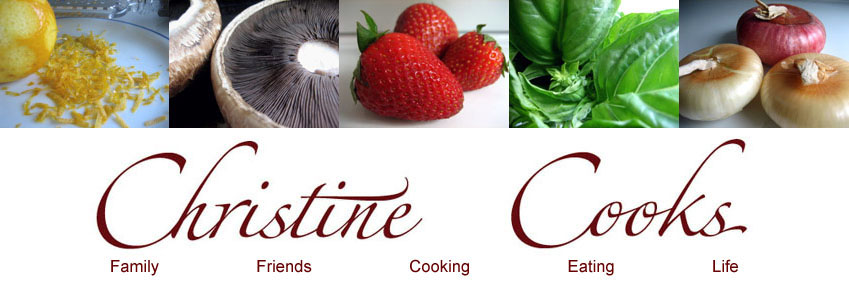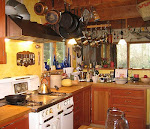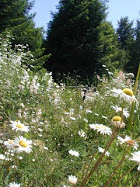Wednesday, November 21, 2007
Final Harvest From The Greenhouse
Tuesday, November 20, 2007
Thanksgiving Recipes - Times Past
This, or a variation of it, is what I usually have simmering on the back of the stove for those who arrive hungry the night before the big day.
Cream of Mushroom & Celeriac Soup
An elegant starter to any holiday meal.
Roasted Beet, Sauteed Fig Amuse Bouche
A fun way to amuse your guests as they sit down to table.
Mashed Yams with Garlic, Chestnuts & Sweet Vermouth
A decadent take on candied yams.
Lime Jello Salad
My mother made this every year. We kids called it Moldy Salad. Thanksgiving would not be the same without it. And, yes, it will be on the Thanksgiving table this year.
Cranberry, Apricot, Ginger Chutney
Put this on the table next to the more traditional cranberry sauce. Yours guests will be delighted. It's delicious on turkey sandwiches the next day.
Turkey Soup
This changes from year to year, depending on how full I am from the night before.
Butternut Squash Bisque with Maple Syrup and Sage
Gives pumpkin pie a run for its money.
Low Carb Pumpkin Cheesecake
Let the dessert speak for itself.
Quince-Raisin Tart Tatin
A quintessential offering of the season.
Copyright © 2005-2007, Christine Cooks. All rights reserved
Monday, November 19, 2007
Thanks and Giving
My friend Katie, blogging from France at Thyme For Cooking , has asked food bloggers to post their most embarrassing holiday recipes for "Skeletons in The Pantry". I do have a recipe for this event, but am not able to post it yet. Meanwhile, reading Katie's intriguing invitation, this little reminiscence just flowed out of my fingertips onto the keyboard this morning. Then I had a hankering to share. I will also share that cleaning and plucking a 40-pound turkey is an experience I will never forget, nor am likely to repeat.
Sunday, November 18, 2007
Home Made Potato Chips
Now before you shake your collective heads in dismay at the high fat, high carb fare appearing on this blog lately, hear me out.
Red Bliss, Yukon Gold, Yellow Finn, Russet, and Purple Peruvians all combined to make a basket of lovely little chips. I dare you to eat just one. It turns out that the purple and red in these little guys are the same antioxident rich anthocyanins that give blueberries their color and health benefits. Of course I didn't know that before we made the chips, but it does help to alleviate the guilt factor a bit.
Friday, November 16, 2007
Eggplant Timbales with Quick and Easy Tomato-Basil Sauce
Eggplant Timbales with Tomato-Basil Sauce
Ingredients:
for the timbales-
4 cups peeled eggplant cubes (1/2-inch dice)
olive oil for the pan
Kosher salt
1 - 15-ounce container low fat ricotta cheese
1/3 cup toasted pine nuts
2 tablespoons chopped sundried tomatoes, packed in oil, drained
3/4 cup coarsely grated parmigiano reggiano cheese
1/3 cup toasted, seasoned bread crumbs
2 eggs
1 1/2 teaspoons Italian herb mix
kosher salt
freshly ground black pepper
Pre-heat oven to 375 degrees.
Using a very sharp chef's knife, slice the peel from the eggplant, cutting off the stem and stern ends.
With the eggplant sitting upright, cut 1/2-inch wide lengthwise slices, then cut each slice in 1/2-inch wide lengthwise strips, then cut those into 1/2-inch cubes.
(It took 1 large and 3 small eggplants to get 4 cups of cubes.)
Place these in a large, well-oiled roasting pan and roast at 375 degrees for about 18 minutes, shaking the pan frequently, until the cubes are golden brown and softened.
Remove the pan from the oven, then the cubes from the roasting pan and set aside to cool.
Turn the oven down to 350 degrees, wipe the roasting pan and set aside. You will use this in a few minutes to bake the timbales.

Meanwhile, combine the ricotta cheese, pine nuts, sundried tomato, parmesan, bread crumbs, Italian herbs (crush them with your fingers as you add them to release the fragrance) and eggs in a bowl and mix well.
Fold in the roasted eggplant as soon as it's cool enough to handle. Mix well but don't break up the cubes.
Season to taste with kosher salt and black pepper if needed.
Fill 6 6-ounce, lightly oiled, ceramic ramekins with the eggplant filling. Place the filled ramekins into the roasting pan and pour enough hot water into the pan to reach halfway up the sides of the ramekins. Cover the pan loosely with foil and roast in the oven for 1 hour or until firm to touch and slightly golden brown.

Using tongs, carefully remove the ramekins from the water bath and set on a heat-proof surface.
While the timbales are roasting...
Christine's original recipe
Ingredients:
1 cipollini onion, chopped fine
2 whole cloves garlic, peeled and minced
handful of fresh basil leaves, left whole
1 large can whole tomatoes (I used Muir Glen Fire-roasted organic, simply the best canned tomato, IMHO)
1/3 cup red wine (I used a fun little Cabernet that I found at our local Co-op for under $10.)
olive oil
flat-leaf Italian parsley for garnish

Preparation:
In a skillet over medium heat, add a teaspoon of good olive oil and the chopped onions and sauté until beginning to soften.
Add the minced garlic and continue to sauté a few more minutes until both are soft and aromatic. Keep the heat adjusted so no burning occurs.
Add the entire can of tomatoes, breaking them up gently with a wooden spoon, then the basil leaves and the red wine.
Allow this mixture to simmer gently for 5 to 7 minutes, then remove from the heat and let it cool slightly.
Pour the chunky sauce into a food processor and pulse until thickly puréed, about 30 seconds.
Pour the sauce back into the skillet and keep warm until ready to serve.

Speaking of serving:
Run a knife around the inside of each ramekin to loosen the timbale.
Place several spoonfuls of sauce on a warmed plate.
Invert the timbale into your clean hand and place upside down on the sauce.
Sprinkle with chopped, fresh flat-leaf parsley. Mangia!
Copyright © 2005-2007, Christine Cooks. All rights reserved
Monday, November 12, 2007
Artichoke Pasta With A Creamy Cheesy Tuna-Artichoke Sauce
So, what got into me? It was the pasta's fault. I couldn't resist. I went into my favorite Italian market and deli (Roy's Toscano Market in Eureka, CA) the other day and these jumped out at me. So softly green. Made in Italy. Two ingredients: Durum wheat semolina and dried artichokes. Produced by Maestri Pastai, the pasta is made using bronze draw plates that give it a rough surface and allows sauces to adhere better. I was doomed.
Then I had to come up with a sauce, didn't I? "Why didn't I skip this step and just glue it to my hips?" is what I ask no one in particular when I've indulged in something as highly caloric as this. Thank goodness I don't indulge very often.
Truly a what's-in-the-pantry sauce, I even managed to use a few locally produced ingredients which delights me no end: Carvalho's "minimal mercury" hand packed white coastal albacore (see Cook's Notes), Midnight Moon aged goat cheese, Humboldt Creamery half n half, cipollini onion and garlic from the farmers market. It almost makes up for the calories. Almost.
Christine's original recipe
Ingredients:
4 cups (about 1 pound) artichoke pasta or other small-shaped pasta
water
kosher salt for the pasta water
olive oil
1 cipollini onion, peeled and chopped
2 garlic cloves, peeled and minced
1 7.5-ounce can premium albacore tuna, broken up with a fork
1 jar marinated artichoke hearts, cut into small bites
1 3/4 cup half n half
1 1/2 cups grated Midnight Moon goat cheese
1/2 cup grated parmigiano reggiano
pinch red pepper flakes
kosher salt and freshly ground black peppercorns to taste
fried capers for garnish
Fill a pasta or stock pot with water and bring to a boil. Add at least 1 tablespoon of salt and the pasta. Bring back to a boil then lower the heat and keep at a simmer until the pasta is just tender.
Drain the pasta and return it to the pot. Drizzle with a small amount of olive oil, toss and keep warm, covered.
In a skillet over medium heat, add 1 tablespoon olive oil and the chopped onion and sauté until softened.
Add the garlic and red pepper flakes and stir until the garlic has softened but not browned.
Add the tuna and the cut up artichoke hearts and stir until warmed through.
Pour in the cream and bring just to a simmer. Do not allow to boil or it will curdle.
Off the heat, add the cheeses, stirring until melted.
Adjust seasonings with Kosher salt and black pepper to taste.
To serve, place the pasta on a warmed plate, spoon the sauce over the pasta and garnish with a few fried capers.
Carvalho's hand-packed albacore is roasted in the can in its own juices so please don't throw the liquid down the drain. Just stir it into the sauce with the tuna.
I highly recommend frying up a handful of capers before beginning to make this dish. It takes no time at all and really gives the sauce a flavor punch.
Copyright © 2005-2007, Christine Cooks. All rights reserved
Sunday, November 11, 2007
Farmers Market Soup
Christine's original recipe
Ingredients:
2 quarts vegetable stock, preferrably homemade
2 cipollini onions, peeled and cut into small dice
5 cloves garlic, peeled and finely minced
1 large celeriac bulb, peeled and cut into 1/2-inch pieces
5 large carrots, scrubbed or peeled and cut into 1/2-inch pieces
2 large red bell peppers, seeded and cut as above
3 portobello mushrooms, gills removed, sliced then cut as above
1 bay leaf, fresh if you have it, dried if you don't
2 teaspoons freshly dried thyme
Kosher salt and freshly cracked black pepper to taste
Preparation:
Wednesday, November 7, 2007
Beginnings Of A Winter Garden
11-9-07:
Ah, country life!



























